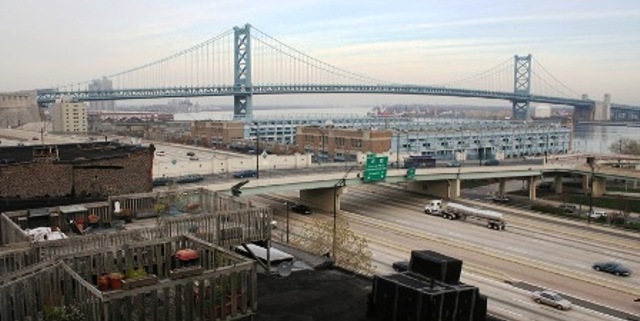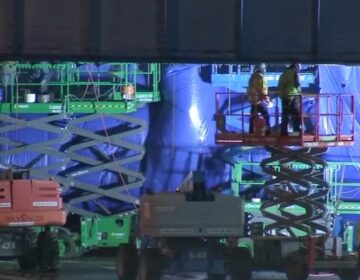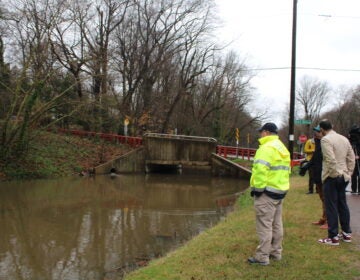How to make all systems go

April 28

A major theme of the Rethinking Philadelphia special section that appears today is breaking down “silos,” conventional divisions that discourage collaborative thinking. In that spirit, the 12-page pullout in the People Paper is a collaboration between the Philadelphia Daily News and PlanPhilly. Read full coverage by clicking the links below.
On the Horizon: Coherent Planning, Zoning
Forget Kumbaya: The Dirty Little Secret
Here are some top names for your “Green” rolodex
The Big Ideas:
Think Globally, Act Collectively
Smart Cities Embrace Sustainability
PlanPhilly will also publish fuller treatments of the Big Ideas covered in the special section in the weeks to come. The first such installment is a deep look at our infrastructure issues.
By Alan Jaffe
For PlanPhilly
Philadelphia is an infrastructure town. Always has been.
Take a look at Billy Penn’s original plan – a model of urban planning centuries ahead of its time: a tight street grid with designated green space at regular intervals, easy access to two rivers, and rolling parklands close by.
At the turn of the 19th century, city leaders followed Penn’s lead, creating Fairmount Park to protect the water supply and building a reservoir at the highest point, with a giant pipe carrying the flow down and beneath what would become the Benjamin Franklin Parkway.
The Delaware River served as the commercial artery, welcoming goods from around the world in the 1800s, and shipping out Pennsylvania products through the mid-1900s. Dozens of rail lines converged on the bustling port, carrying coal and other resources to the Philadelphia industrial complex that became known as the “Workshop of the World.”
These are all elements of infrastructure, the framework of a metropolitan center: its roads, rails and waterways, water systems and energy utilities, and in the 21st century, telecommunications, which transport the goods called information.
Infrastructure is our foundation and our future. But in the 20th century, the city’s infrastructure began to show its age.
Center City streets became jammed, and the expressways and bridges to the suburbs are overburdened.
The Philadelphia port couldn’t compete with the deeper, oceanfront harbors to the north and south. The coal industry was transplanted by other energy sources. Cramps Shipyard closed down, and weeds grew in the rail lines.
The combined sewer and water system that serve most city residents flow through century-old pipes, and their capacity is overwhelmed by every heavy rain. Streets and basements flood, and polluted storm water empties into the rivers.
As these systems competed for attention and repair, funding was cut for maintenance of parks and open spaces. Trash and blight increased as the tree canopy diminished.
Overburdened, outmoded, overwhelmed, underfunded.
The problems aren’t unique to Philadelphia. The infrastructures of cities around the country – and not just the older, Eastern giants – have been crumbling. The collapse of the I-35W Bridge in Minneapolis on Aug. 1, 2007, which killed 13 people, was a real and symbolic disaster. Governments at every level have been looking inward, seeking ways to support the underlying facilities and systems on which they depend.
“The Minnesota bridge collapse was a huge wakeup call,” said Barry Seymour, executive director of the Delaware Valley Regional Planning Commission. “Every state accelerated bridge inspections and realized how many are in a deteriorating state.” They shifted large amounts of work and money into bridge rehabilitation, he said. “Making sure a system is safe trumps everything else.”
The condition of the nation’s bridges and roads captured the attention and imagination of the federal government as well. President Obama’s American Recovery & Reinvestment Act directs between $81 billion and $126 billion (depending on who is doing the analysis) toward infrastructure investment. A big share, about $53 billion, goes toward bridge and highway construction and other transportation investment.
But $16 billion in ARRAS funding is aimed toward energy concerns and achieving energy independence. About $13 billion will go toward providing clean drinking water and controlling wastewater. More than $7 billion will be available for broadband deployment in underserved areas.
Where these infrastructure needs mainly interconnect is “metropolitan America,” according to the Brookings Institution. Cities are the “economic engines” of the country, explains the 2008 Brookings study, Blueprint for American Prosperity: Unleashing the Potential of a Metropolitan Nation.
The 100 largest cities are home to two-thirds of the U.S. population. And they are where 72 percent of seaport tonnage arrives and departs; 78 percent of interstate miles are traveled, 92 percent of air passengers come and go; and 93 percent of rail passengers board.
This region’s metro centers will be recipients of much needed ARRAS funds, but the needs are great.
At the top of the DVRPC wish list is “a dedicated fund for infrastructure projects,” Seymour said. Federal transportation legislation is due to expire later this year, Pennsylvania’s Act 44, which provides a long-term stream of transportation funding, is “up in the air,” and New Jersey’s Transportation Trust Fund is “running dry,” he said. “Both states are in crisis for transportation funding.”
On the DVRPC agenda are the rebuilding of Route 42 to I-95 and I-76, which needs $900 million to complete; PATCO’s extension of rail lines into Gloucester County, a $1 billion project; and the rehabilitation of I-95 in Philadelphia, which still needs $2 billion.
Seymour’s wish for “dedicated” funding may be partly answered by the federal proposal for a National Infrastructure Reinvestment Bank that would invest $60 billion over a ten-year period in highways, technology, and other projects. Even that wouldn’t let states off the hook for coming up with their own reconstruction money, and Seymour is waiting for “local governments to get some skin in the game and realize this is important.”
In the meantime, municipal planning and community engagement have become valuable currency in addressing Philadelphia’s challenges.
Planning for a revived Delaware waterfront has produced a long list of big ideas and concrete actions that can reduce the stress on the region’s infrastructure.
The dense street grid proposed in the Civic Vision for the Central Delaware coordinated by PennPraxis, the clinical arm of Penn’s design school, would have a direct effect on the chronic traffic congestion on Columbus Boulevard and I-95. But it has much larger implications for the region.
The waterfront grid, an extension of Penn’s original map, would stimulate the expansion of Center City by about 30 percent into mixed-use development along the river. Those new neighborhoods would mean fewer suburban commuters and more momentum for the metropolitan economic engine seen in the Brookings study.
The Civic Vision also foresees the return of rail to the riverfront, this time a light rail line running along an urban boulevard, and branching west to reconnect with the rest of Center City.
The much-debated, much-awaited dredging of the Delaware and the Southport project will help create a world-class containerized shipping facility with the potential of employing 175,000, according to current projections.
The city’s plumbing problems amount to about $350 million in water and sewer needs, Seymour said, to effectively replace and retrofit the system. “We have a lot of old pipes in the ground.” But the Philadelphia Water Department is engaged in a multi-pronged approach, addressing not only the gray infrastructure (the old pipes), but also creating a green infrastructure (environmental management of storm water runoff), and focusing on blue infrastructure (restoring the waterways).
Regarding the natural green infrastructure, Seymour acknowledges the region’s progress in turning the situation around. “The region has done remarkably well at preserving open space. Most of the suburban counties and a surprising number of local governments have voted to tax themselves to buy open space,” he said, and the area’s farmland preservation programs have become national models.
In the city, the parks network has revived green spaces throughout the city, and the recent merger of the municipal parks and recreation departments has inspired new hope for preserving much more of Fairmount Park, that beautiful open space that has been with Philadelphians since the beginning.
There are other, even bigger issues at work in planning the region’s infrastructure and keeping it sustainable – that buzz word that looks into our common future. Seymour points to energy and climate change on the horizon. Where we choose to live, how we move around, how we develop our land and waterfronts – all those infrastructure decisions — will determine our place in this new century.
Contact the reporter at alanjaffe@mac.com
WHYY is your source for fact-based, in-depth journalism and information. As a nonprofit organization, we rely on financial support from readers like you. Please give today.






